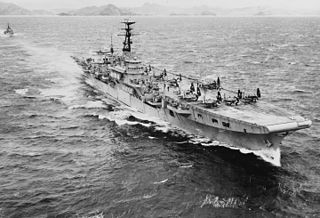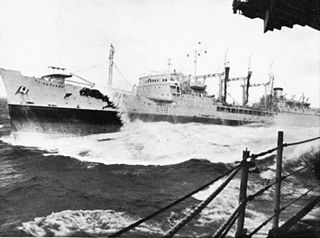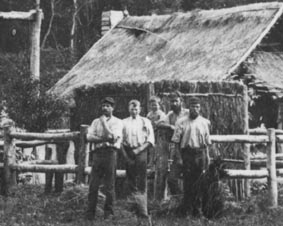Related Research Articles

William Henry Beveridge, 1st Baron Beveridge, was a British economist and Liberal politician who was a progressive and social reformer. His 1942 report Social Insurance and Allied Services served as the basis for the post-World War II welfare state put in place by the Labour government elected in 1945. He was considered an authority on unemployment insurance from early in his career, served under Winston Churchill on the Board of Trade as Director of the newly created labour exchanges, and later as Permanent Secretary of the Ministry of Food. He was Director of the London School of Economics and Political Science from 1919 until 1937, when he was elected Master of University College, Oxford.

The 1942 Design Light Fleet Carrier, commonly referred to as the British Light Fleet Carrier, was a light aircraft carrier design created by the Royal Navy during the Second World War, and used by eight naval forces between 1944 and 2001. They were designed and constructed by civilian shipyards to serve as an intermediate step between the expensive, full-size fleet aircraft carriers and the less expensive but limited-capability escort carriers.
Manpower, or human resources, are the people of a workforce in an organisation

ManpowerGroup is a Fortune 500 American multinational corporation headquartered in Milwaukee, Wisconsin. Founded in 1948 by Elmer Winter and Aaron Scheinfeld, ManpowerGroup is the third-largest staffing firm in the world behind Swiss firm Adecco and Dutch firm Randstad. The company provides administrative & support services, professional services, and business services through its four primary brands: Manpower, Experis, Right Management, and ManpowerGroup Solutions.

The 51st Battalion, Far North Queensland Regiment is an Australian Army Regional Force Surveillance Unit headquartered at Porton Barracks in Cairns. The battalion's primary role is to conduct reconnaissance and surveillance tasks in support of border security operations. Its area of operations includes the Torres Strait and the Cape York littoral environment. Additional tasks for 51FNQR include the collection and collation of military geographic information as well as community engagement and disaster relief operations.
The Kalinga War was fought in ancient India between the Maurya Empire under Ashoka and the state of Kalinga, an independent feudal kingdom located on the east coast, in the present-day state of Odisha and north parts of Andhra Pradesh. It is presumed that the battle was fought on Dhauli hills in Dhauli which is situated on the banks of Daya River. The Kalinga War included one of the largest and deadliest battles in Indian history. Kalinga did not have a king as it was culturally run without any.

The Jungle division was a military organisation adopted in early 1943 by the Australian Army during the Second World War. This organisation was a much lighter version of the standard British-pattern infantry division used during previous campaigns in the deserts of the Mediterranean and Middle East Theatre fighting the Germans and Italians in 1940 and 1941 and was optimised to meet the needs of jungle warfare against the Japanese in the South West Pacific Area. Jungle divisions were smaller and had fewer heavy weapons, vehicles and support units than the British-pattern division previously used and had an establishment of just 13,118 men, approximately 4,000 fewer than a standard division. The bulk of the reduction occurred among the administrative, transport and artillery units. The conditions that prevailed in the South West Pacific Area led the Australian Army to initially convert five infantry divisions to Jungle divisions, although this was later increased to six. Divisions converted to the jungle organisation included three Militia divisions: the 3rd, 5th and 11th and the three Australian Imperial Force (AIF) divisions: the 6th, 7th, 9th. Despite some modifications, this re-organisation proved successful during later Australian operations in New Guinea, New Britain, Bougainville, Aitape-Wewak and Borneo in 1944–45.

The Women's Royal Australian Naval Service (WRANS) was the women's branch of the Royal Australian Navy (RAN). In 1941, fourteen members of the civilian Women's Emergency Signalling Corps (WESC) were recruited for wireless telegraphy work at the Royal Australian Navy Wireless/Transmitting Station Canberra, as part of a trial to free up men for service aboard ships. Although the RAN and the Australian government were initially reluctant to support the idea, the demand for seagoing personnel imposed by the Pacific War saw the WRANS formally established as a women's auxiliary service in 1942. The surge in recruitment led to the development of an internal officer corps. Over the course of World War II, over 3,000 women served in the WRANS.
The 4th Brigade is a brigade-level formation of the Australian Army. Originally formed in 1912 as a Militia formation, the brigade was re-raised for service during World War I, elements of the brigade served at Gallipoli and in the trenches on the Western Front before being disbanded in 1919. In 1921, the brigade was re-raised as a unit of Australia's part-time military forces, based in the state of Victoria. During World War II the brigade served in the New Guinea and New Britain campaigns. Following the war, the brigade formed part of the 3rd Division, however, it was later reallocated to the 2nd Division, where it serves as a Reserve combined-arms formation including units and personnel from all corps of the Army including armoured, infantry, artillery, engineers, signals and ordnance.

The Tide class was a series of six replenishment oilers used by the British Royal Fleet Auxiliary (RFA), the Royal Australian Navy (RAN), and the Chilean Navy.

The Australian Women's Land Army (AWLA) was an organisation created in World War II in Australia to combat rising labour shortages in the farming sector. The AWLA organised female workers to be employed by farmers to replace male workers who had joined the armed forces.

Human power is work or energy that is produced from the human body. It can also refer to the power of a human. Power comes primarily from muscles, but body heat is also used to do work like warming shelters, food, or other humans.
The Civil Constructional Corps (CCC) was an organised labour force of men who volunteered or were conscripted (manpowered) into service to provide wartime infrastructure during World War II in Australia.

The 15th Brigade was an infantry brigade of the Australian Army. Originally raised in 1912 as a Militia formation, the brigade was later re-raised in 1916 as part of the First Australian Imperial Force during World War I. The brigade took part in the fighting on the Western Front in France and Belgium during 1916–1918 before being disbanded in 1919. After this it was re-raised as a part-time unit of the Citizens Force in 1921 in Victoria. During World War II the brigade undertook defensive duties and training in Victoria and Queensland, before being deployed to New Guinea in 1943. Over the course of 1943 and 1944, it took part in the Salamaua–Lae, Markham–Ramu campaigns before returning to Australia in late 1944. In mid-1945, the brigade was committed to the Bougainville campaign, before being disbanded following the end of hostilities.

Australian Paraguayans are citizens of Paraguay of Australian background. Most of them are descendants of a group of radical socialist Australians who voluntarily went to Paraguay to create a failed master-planned community, known as Nueva (New) Australia.
The home front during World War I covers the domestic, economic, social and political histories of countries involved in that conflict. It covers the mobilization of armed forces and war supplies, but does not include the military history. For nonmilitary interactions among the major players see Diplomatic history of World War I.

Central Area Command was one of several geographically based commands raised by the Royal Australian Air Force (RAAF) during World War II. It was formed in March 1940, and covered the central portion of New South Wales. Headquartered at Sydney, Central Area Command was responsible for air defence, aerial reconnaissance and protection of the sea lanes within its boundaries. It was disbanded in August 1941 and control of its units taken over by other RAAF formations. Proposals in 1943–44 to raise a new Central Area Command did not come to fruition.

No. 1 (Training) Group RAAF was a Royal Australian Air Force (RAAF) group. It was formed in Melbourne in August 1941 as part of a reorganisation of the air force, and was disbanded after the war in January 1946.
No. 2 (Training) Group RAAF was a Royal Australian Air Force (RAAF) group. It was formed in Sydney in August 1941 as part of a reorganisation of the air force, and was disbanded after the war in March 1946.

Reich Defense Commissioner was a governmental position created in Nazi Germany at the outbreak of World War II on 1 September 1939. Charged with overall defense of the territory of the German Reich, there was originally one Reich Defense Commissioner for each of 15 Wehrkreise. On 16 November 1942, the geographical scope was reduced to the Gau level, raising the number of Reich Defense Commissioners to 42.
References
- 1 2 3 Second World War – Reserved occupations, Australian War Memorial encyclopedia.
- ↑ Joan Beaumont, Australia's War, 1939-1945 (1996), p. 63.